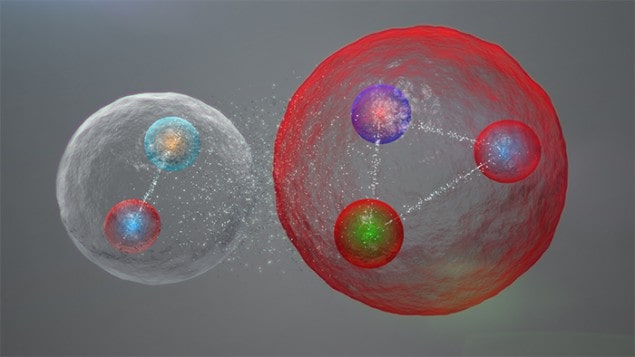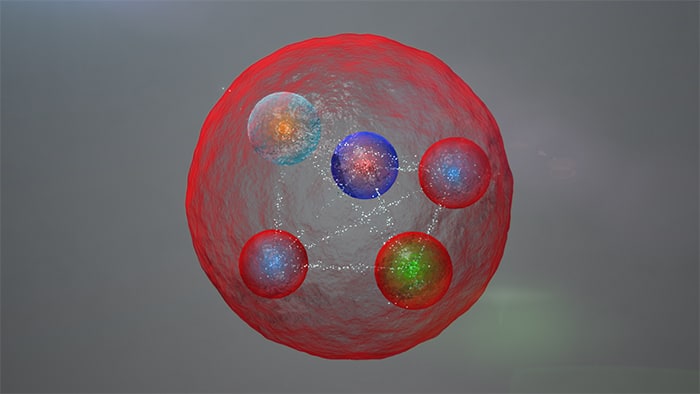
The best evidence yet for the existence of a new type of particle called a pentaquark has been unveiled by physicists working on the LHCb experiment on the Large Hadron Collider (LHC) at CERN. Containing five bound quarks, pentaquarks were first predicted to exist in the late 1970s, and evidence for their existence emerged from several labs in the 2000s, only to be contradicted by experiments done elsewhere. While this latest evidence from LHCb is very strong, the data do not reveal exactly how the five quarks are bound together – something that will be the subject of further studies at CERN.
Most known hadrons are either mesons, which contain a quark and an antiquark, or baryons, which comprise three quarks. A proton contains two “up” quarks and one “down” quark, while a positive kaon contains an up quark and a “strange” antiquark. But the theory of the strong force – quantum chromodynamics (QCD) – allows for other types of baryons, providing that the number of quarks minus the number of antiquarks is a multiple of three. In particular, it allows for particles containing four quarks and one antiquark.
In the early 2000s several independent groups of physicists reported the observation of pentaquarks, most with masses in the 1520–1560 MeV/c2 range. Since then, however, other research groups have failed to find further evidence for these pentaquarks, and by the start of this decade, the consensus in the particle-physics community was that the pentaquark had yet to be discovered.
9σ significance
Now, physicists at LHCb have found compelling evidence for the existence of pentaquarks – this time at the much higher mass of about 4400 MeV/c2. The team studied the decay of the Λb baryon into three other particles: a J/ψ, proton and a charged kaon. A careful analysis of the decay products revealed that two intermediate states were sometimes involved in their production. Dubbed Pc+ (4450) and Pc+ (4380) – where the numbers are the particle masses in units of MeV/c2 – both particles have been observed with statistical significances greater than 9σ. In particle physics a significance greater than 5σ is consider to be a discovery.
The LHCb team is confident that the particles are indeed pentaquarks that comprise two up quarks, one down quark, one charm quark and one anticharm quark. “Benefitting from the large data set provided by the LHC, and the excellent precision of our detector, we have examined all possibilities for these signals, and conclude that they can only be explained by pentaquark states,” explains LHCb physicist Tomasz Skwarnicki of Syracuse University in the US.
LHCb physicist Tim Gershon of the University of Warwick in the UK explains why he is confident of the result: “The LHCb analysis is significantly different from those of previous experiments that found hints of [pentaquarks] that were later disproved.” He adds that “LHCb has analysed all of the available information in the decay distribution to prove that the peak in the mass distribution cannot be a fake caused by other processes.”
Subatomic molecules
The LHCb data do not, however, reveal how the five quarks are bound within the pentaquark. The five quarks could be tightly bound within a single structure, for example. Another possibility is that a quark and antiquark are bound together to form a meson and the remaining three quarks form a baryon. The meson and baryon could then be bound to each other to create a structure resembling a subatomic molecule.
“Studying [the pentaquark’s] properties may allow us to understand better how ordinary matter, the protons and neutrons from which we’re all made, is constituted,” says LHCb spokesperson Guy Wilkinson. This will have to wait for more data from the current run of the LHC, which started last month.
The pentaquarks are described in a paper submitted to Physical Review Letters and a preprint is available on arXiv.




